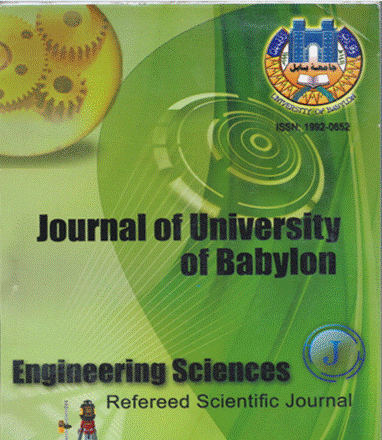Abstract
In the present work the aerodynamic characteristics of a bus was studied. Flow analyses was carried out assuming two dimensional, steady incompressible and viscous. The effect of speed and yaw angle variation were investigated separately. Experimental and theoretical investigations were carried out. A bus model of 1:20 scale ratio was used for experimental testes. A wooden bus model was made with smooth surfaces to simulate the prototype.
The tests were carried out in a low speed wind tunnel, the air speed was varied from 14.5 m/s to 24.5 m/s and yaw angle from 0o to 15.
A package program (Ansys 5.4) was used to carry out the theoretical study. This gave a good ability to calculate the pressure and velocity distribution and sketching the eddies in the near wake behind the bus model. It was found that increasing the yaw angle increases the drag and pressure coefficients .At air speed equals to 14.5 m/s the difference in the pressure coefficient in the flow direction CP(front-rear) varies from 0.05 at Q=0o to -0.055 at Q=10o, .For the same condition the drag coefficient varies from 0.72 to 0.76.
The comparison made between the experimental results, and some experimental published data showed a good agreement. The results obtained by Ansys 5.4 program for the specific configureuration were compared with the present experimental work and they showed a reasonable agreement .
The tests were carried out in a low speed wind tunnel, the air speed was varied from 14.5 m/s to 24.5 m/s and yaw angle from 0o to 15.
A package program (Ansys 5.4) was used to carry out the theoretical study. This gave a good ability to calculate the pressure and velocity distribution and sketching the eddies in the near wake behind the bus model. It was found that increasing the yaw angle increases the drag and pressure coefficients .At air speed equals to 14.5 m/s the difference in the pressure coefficient in the flow direction CP(front-rear) varies from 0.05 at Q=0o to -0.055 at Q=10o, .For the same condition the drag coefficient varies from 0.72 to 0.76.
The comparison made between the experimental results, and some experimental published data showed a good agreement. The results obtained by Ansys 5.4 program for the specific configureuration were compared with the present experimental work and they showed a reasonable agreement .
Abstract
في البحث الحالي تم دراسة الخواص الديناهوائية للحافلة. تم تحليل الجريان على اساس ثلاثي الابعاد ومستقر ولا انضغاطي ولزج. تمت دراسة تأثير تغير السرعة وزواية الانحراف لكل سطح من السطوح بشكل منفصل.
اجريت دراسة عملية ونظرية. تم استخدام نموذج حافلة بمقياس رسم (1 : 20) للاختبارات العملية، تم تصنيع نموذج خشبي للحافلة بسطوح ملساء مشابهة لسطوح الحافلة اجريت الاختبارات في نفق هوائي ذي سرعة منخفضة. تم تغيير سرعة الهواء في الاختبارات من (14.5 م/ ثا) الى (25.5 م/ ثا) وتم تغيير. الانحراف من 0 – 15 درجة واستخدمِ برنامج الانسزللدراسة النظرية.ان استخدام هذا البرنامج يعطي امكانية جيدة لحساب توزيع الضغط والسرعة ورسم الدوامات المتولدة عند الاثر خلف الحافلة. وقد وجد ان الزيادة بزاوية الانحراف تؤدي الى زيادة بالاعاقة والضغط حيث وجد عند سرعة14,5 م/ثا ان معامل الضغط يتراوح بين 0,05 عند زاوية انحراف تساوي صفرا الى -0,055 عند الزاوية 10 ولنفس السرعة وان الاعاقة تتراوح بين 0,72 الى 0,76 ان المقارنة بين النتائج العملية والنتائج العملية لابحاث سابقة كانت متطابقة بشكل جيد وكذلك ان المقرنة بين النتائج العمليةو النظرية لهذا البحث اعطت تقارب معقول.
اجريت دراسة عملية ونظرية. تم استخدام نموذج حافلة بمقياس رسم (1 : 20) للاختبارات العملية، تم تصنيع نموذج خشبي للحافلة بسطوح ملساء مشابهة لسطوح الحافلة اجريت الاختبارات في نفق هوائي ذي سرعة منخفضة. تم تغيير سرعة الهواء في الاختبارات من (14.5 م/ ثا) الى (25.5 م/ ثا) وتم تغيير. الانحراف من 0 – 15 درجة واستخدمِ برنامج الانسزللدراسة النظرية.ان استخدام هذا البرنامج يعطي امكانية جيدة لحساب توزيع الضغط والسرعة ورسم الدوامات المتولدة عند الاثر خلف الحافلة. وقد وجد ان الزيادة بزاوية الانحراف تؤدي الى زيادة بالاعاقة والضغط حيث وجد عند سرعة14,5 م/ثا ان معامل الضغط يتراوح بين 0,05 عند زاوية انحراف تساوي صفرا الى -0,055 عند الزاوية 10 ولنفس السرعة وان الاعاقة تتراوح بين 0,72 الى 0,76 ان المقارنة بين النتائج العملية والنتائج العملية لابحاث سابقة كانت متطابقة بشكل جيد وكذلك ان المقرنة بين النتائج العمليةو النظرية لهذا البحث اعطت تقارب معقول.
